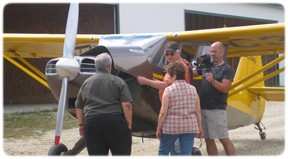Piece of Aviation History Finds New Home in Turner, Maine
Durham-resident and family physician Dr. Louis Hanson and his
historic 1946 Stinson Voyager will be featured in an upcoming
documentary film about Aviation Safety Resources (ASR), a Long
Island-based company founded by Dario Manfredi, the son of the
Stinson's original owner. The mini-documentary, being produced by
veteran New York filmmaker Kai Simonsen, will highlight the history
and potential uses of ASR's patented technology.

By way of background, Manfredi's father, also Dario, and his
partner, Angelo Raiti, began in the early 1960s to devise a system
that would safely land a plane and its passengers in the event of a
catastrophic in-flight emergency. They purchased the Stinson Model
108 Voyager 9 (Serial Number 13, Registration N39443). With the
help of a parachute company and field engineers, they equipped it
with special wing attachment pins, three parachutes and explosive
devices that the pilot could activate to separate the fuel-bearing
wings from the fuselage and bring each piece safely to earth under
its own parachute.
They tested their system in an FAA-sanctioned test flight on
November 9, 1967 at Lakehurst Navel Air Station in New Jersey. The
system worked as planned, separating the wings and bringing the
fuselage down safely with little or no damage.
Shortly after the test flight, Manfredi's father was forced to
sell his Stinson. He was in the process of retrofitting a second
Stinson for further FAA tests and certification when a stroke took
his life in 1984.
After many years in storage, the original Stinson was
reassembled, reconditioned and purchased by Dr. Hanson in 2002. A
passionate recreational pilot, Dr. Hanson now houses his plane in a
small hanger at Twitchell's Airport and Seaplane Base in Turner,
where his flight instructor told him of the plane's amazing
history.
"When I Iearned about the plane's history, I did some research
and contacted Dario Manfredi to get acquainted and share my
experience with the aircraft that inspired his father's invention,"
said Dr. Hanson. "I feel very fortunate to own this piece of
aviation history and welcomed the opportunity to participate in the
filming of the documentary."
Dario Manfredi and his sister Savia Giarraffa have been on a
ten-year mission to update their father's original concept and have
assembled a team of test pilots, parachute and ballistics experts,
and avionics engineers bring their father's invention to market.
ASR currently has two patents pending with the U.S. Patent and
Trademark Office – one for the TriChute Safe Landing System
and another for a complementary sensor-based Smart Recovery System
(SRS).

Filming With The Stinson
Applying sensor systems currently available in commercial and
military aircraft to General Aviation (GA), the SRS 1.0 brings all
systems in GA aircraft into one "black box" that constantly
monitors fight, alerts the pilot to problems with any device or
system, and outlines corrective action. The company's more advanced
SRS 2.0 alerts the pilot, but if the pilot does not respond, it
also takes action to rectify the situation by automatically
deploying the appropriate safety system or device available on the
aircraft.
Dario, Savia and an ASR film team traveled from New York to
Maine late last summer to meet Dr. Hanson, examine the Stinson, and
fly in the plane inspired the company's technology.
"Hearing from Dr. Hanson out of the blue and reconnecting with
our father's airplane has been significant on many levels,"
Manfredi said. "First, the very fact that the original airframe is
structurally sound and being flown safely 40 years after it was
disassembled in flight proves the validity of our company's
underlying technology. Second, is the emotional impact of
reconnecting with our father through the plane that was the love of
his life. It's hard to explain the emotions we felt when we first
laid eyes on it and recalled time we spent with our father as he
worked day and night to make his dream of safer general aviation a
reality."
Dr. Hanson calls the elder Manfredi's efforts "inspired" and
"courageous."
"ASR's system would add a layer of safety that's hard to
measure," he said. "It would provide pilots like me with a new
sense of confidence and calm knowing that, in the face of
unanticipated weather or mechanical failures, the system would
ensure that pilots and passengers can be brought down safely and
unharmed. I will certainly consider retrofitting my Stinson with
this system once it is commercially available."
The company continues to seek investors.
 Airbus Racer Helicopter Demonstrator First Flight Part of Clean Sky 2 Initiative
Airbus Racer Helicopter Demonstrator First Flight Part of Clean Sky 2 Initiative Diamond's Electric DA40 Finds Fans at Dübendorf
Diamond's Electric DA40 Finds Fans at Dübendorf ANN's Daily Aero-Term (04.23.24): Line Up And Wait (LUAW)
ANN's Daily Aero-Term (04.23.24): Line Up And Wait (LUAW) NTSB Final Report: Extra Flugzeugbau GMBH EA300/L
NTSB Final Report: Extra Flugzeugbau GMBH EA300/L Classic Aero-TV: 'Never Give Up' - Advice From Two of FedEx's Female Captains
Classic Aero-TV: 'Never Give Up' - Advice From Two of FedEx's Female Captains




